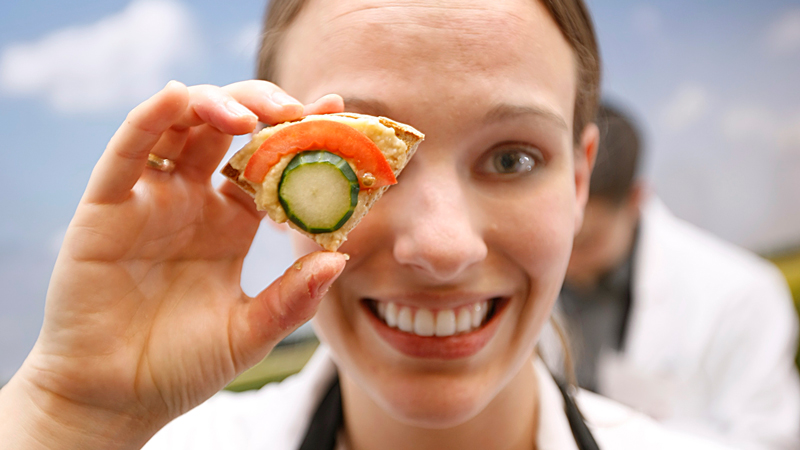Turning the kitchen into a classroom
By Jan Jarvis

As someone who enjoys a good meal, Molly Chang was eager to sample the different dishes that are cooked each week in the Culinary Medicine course.
“I love trying out recipes and eating new foods, so cooking with friends and getting a free meal is right up my alley,” she said.
But as a medical student, Chang could see past the tasty cuisine.
“Besides having a set of amazing recipes and handouts for my future patients, I feel more comfortable discussing my patient’s eating habits with them, partnering with them to make dietary changes, or referring them to a nutritionist,” said Chang, a second year Texas College of Osteopathic Medicine student. “I think all students should be required to take this class.”
The six-week Culinary Medicine class brings Texas Christian University and UNT Health Science Center students together for hands-on lessons that turn the kitchen into a classroom. The program is the first of its kind in Texas and one of only about a dozen around the country.
It’s so popular that when it was introduced in 2014, a lottery determined the first participants.
Lessons are taught by faculty from both schools, and students benefit from each other’s perspectives on medicine and nutrition. There’s required reading, group discussions and something that’s rarely found in medical school or college curriculums: the joy of eating.
“This program gets students out of the classroom and into a kitchen,” said Frank Filipetto, DO, Interim Dean of TCOM. “That’s just fun.”
The class explores the link between diet, disease and the role food plays in the prevention of illness. It’s a concept whose time has come, said Lyn Dart, PhD, RD, LD, Associate Professor in the Department of Nutritional Sciences at Texas Christian University.
“We’ve got 60 to 70 years of research behind this relationship between diet and disease,” Dr. Dart said. “And we have physicians whose patients are asking for more information about healthy eating and disease prevention.”
Diet and health
For decades, Americans have faced an epic battle with the bulge – and for the most part, they’re losing.
Today 70 percent of adults are overweight or obese, according to a National Health and Nutrition Examination Survey. Over the years, Americans’ fast food frenzy has put them at risk for hypertension, diabetes and other chronic diseases.
It’s only getting worse. There are 29 million people in the United States who have Type 1 or Type 2 diabetes. Each year about 1.7 million adults learn they have the disease.
If things don’t change, 40 percent to 50 percent of adults will have diabetes by 2040, said Milette Siler, RD, LD, Community Dietitian at the Moncrief Cancer Institute in Fort Worth. But it’s possible to change those trends though healthy eating.
“If you can get a patient with diabetes eating healthier and exercising, you can see especially dramatic results,” said Siler, a TCU graduate who completed the culinary medicine program.
In a three-year study of adults with Type 2 diabetes, 30 percent of patients were able to control the disease with a healthy diet and exercise alone as opposed to with medication.
Healthy tips
It’s one thing to recognize the importance of a healthy diet and another to make a habit of eating kale and cauliflower.
In the class, students learn simple ways to eat healthier foods with the expectation that they’ll be prepared to pass that knowledge onto their patients.
“It’s not, ‘Here’s what you should eat,’” Dr. Dart said. “But rather, ‘Here’s how to make it taste really good.’”
Tasty translates into savory – or the more trendy term “umami.” Described as brothy or meaty, umami was discovered in Japan and is the fifth taste after salt, sweet, sour and bitter.
“When you taste something that is savory, it sends a signal to the brain that tells the body. ‘I’m satisfied, I’m full,’” Siler said.
Add crunch and color to the recipe, and it’s more tantalizing to taste buds. Herbs and spices give recipes some zing and provide an alternative to salt, which can send sodium levels climbing.
Most of the salt that Americans consume comes from processed and restaurant food. Between 80 percent and 90 percent of sodium is from processed or restaurant food, Siler said.
“Just eating at home will help you naturally lower your risk of hypertension,” she said.
Eating healthy needs to be easy. Complicated cuisine just doesn’t work in our time-crunched culture.
“With culinary medicine, the emphasis is not on exotic recipes,” Siler said. “It’s on simple ingredients that can be purchased at your local grocery store.”
The kitchen as classroom
During the class, students learn everything from ways to pick the perfect avocado to how to use a knife like a sushi chef. They also discover firsthand how delicious healthy food can taste.
“It inspired me to eat healthier and try foods that I never would have on my own,” Chang said.
Students also see how foods affect health and ways to address specific medical conditions. For patients with hypertension, for example, reducing sodium is critical.
“I was made aware of how different types of food affect not only the overall health of a person, but individual processes such as inflammatory or autoimmune,” said Kaitlin Bennett, a student in the UNTHSC’s physician assistant program. “The class also gave me quite a few great recipes to not only suggest to my patients, but utilize in my own life.”
Most of the recipes are built on the Mediterranean diet, which involves eating healthy foods such as fish, vegetables and whole grains. The diet is used in class for good reason. A 2007 National Institutes of Health study of 380,000 adults provided strong evidence that, over a span of 10 years, a Mediterranean diet was associated with reduced mortality from all causes. In women, for example, the risk of death from cancer decreased 20 percent.
Students can taste the benefits. Each week classes are split into small groups that follow different
recipes. In one of the classes, different versions of spaghetti are prepared for students to compare nutrient content as well as taste.
While one group might cook “lunch lady” spaghetti with white pasta and lots of meat, other groups would modify the recipe, making each one a little healthier. The final version includes whole pasta with a high vegetable content.
The take-home messages: Food can taste good and still reduce the risk of death from chronic disease. And instead of overhauling someone’s diet, it’s better to make small changes that people can stick with.
A team approach
It might not be realistic to expect physicians to add a dietitian’s cap to their wardrobes. But the class does get students thinking about how to start the conversation with patients.
“Right now physicians may tell their patients to improve their diet but they don’t tell them how to do it or give them practical information,” Dr. Filipetto said. “Students who take this course know what it means and how to do it.”
As physicians, the students will be better prepared to point patients in the right direction.
“What I see as realistic is the dietitian and physician working together as part of the medical team.” he said. “The physician doesn’t have to do it all but knows where and how to reach out for help.”
TCOM student Stephanie Abrams said she expects to use the skills she learned in the class with her patients and in her own life.
“This class did more than just give me the foundation and some tools to pass onto future patients. It has helped me understand and alter my own diet in such a fun way,” she said “Instead of telling a patient to change their entire diet in one visit, I know what small steps to suggest that can help them change their lifestyle.”





Social media